May 5, 2015
Commissioner for Patents of the United States Patent and Trademark Office
Attn: Michael Cygan
Senior Legal Advisor, Office of Patent Legal Administration
Office of the Deputy Commissioner for Patent Examination Policy
P.O. Box 1450
Alexandria, VA 22313-1450
via email: WorldClassPatentQuality@uspto.gov
Re: Comments in response to USPTO’s Request for Comments on Enhancing Patent Quality, Fed. Reg. Vol. 80, No. 24 (February 5, 2015)
Dear Commissioner:
We are attorneys with Sterne Kessler Goldstein & Fox, an intellectual property law firm with more than 170 IP professionals in Washington, D.C. In 2014 alone, our firm filed over 1,200 design applications worldwide, over 400 of which were filed at the USPTO. Together, we have over thirty-four years of experience filing and prosecuting design patent applications before the USPTO on behalf of over 100 companies and individuals, including two companies that are regularly among the top fifty annual US design patent grantees.
As a firm and as individual practitioners, we regularly contribute to efforts to shape and improve design prosecution practice. We work with the USPTO and foreign patent offices, and with non-governmental intellectual property groups around the world.
We write today to present the Office with a straightforward, uncontroversial, and necessary suggestion to improve the quality of design patents: print them clearly.
Enhancing the print quality of design patents falls under the Office’s Proposal 3: Clarity of Record.
Clarity in design patent drawings is essential.
The Office’s rules require that a design patent’s claim be in formal terms, covering the design for an article “as shown and described” in the required drawings. 37 CFR §§ 1.152, 1.153. Since the drawings define the claimed subject matter, the Office recognizes the need for high-quality drawings in an application:
The necessity for good drawings in a design patent application cannot be overemphasized. As the drawing constitutes the whole disclosure of the design, it is of utmost importance that it be so well executed both as to clarity of showing and completeness, that nothing regarding the design sought to be patented is left to conjecture.
MPEP § 1503.02. But the MPEP makes no such pronouncement about the quality of drawings in an issued patent.
We contend that high quality drawings are at least as important in an issued patent as in an application. The public deserves to know the extent of the property right protected by a patent, and the patentee deserves to have a clear representation of that right. We do not believe these to be controversial positions.
The print quality of the US Patent Office’s design patents is uniformly low, often obfuscating the exclusive rights they represent.
Design patent drawings often do more than simply depict a design. The types of lines used can be important indicators to represent portions of the design that are claimed, and portions that are not. For example, solid lines are often used to show claimed portions of a design, while broken lines are often used to show unclaimed portions or environment. Shade lines are often used to help show contour. A clear representation of these and other different line types helps the public to understand which portions of a depicted design it may be precluded from practicing.
Unfortunately, the Office’s issued design patents not only consistently fail to represent patented designs with the same clarity with which they were presented in their applications, but even worse, they are often so poor that they are unintelligible or essentially depict a different design than that which was examined and allowed by the examiner.
For example, the printing quality of the Office’s design patents is often so poor that lines in the drawings of the issued patent are not represented as they were in the application. Examples include solid claimed lines appearing as broken unclaimed lines in the issued patent, or boundary and shade lines printing so blurry that they appear to run together, obscuring or misrepresenting portions of the design.
Some examples will help elucidate these points.
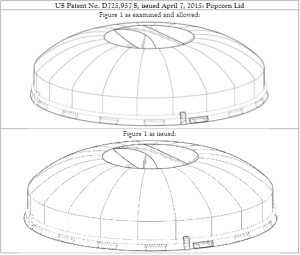
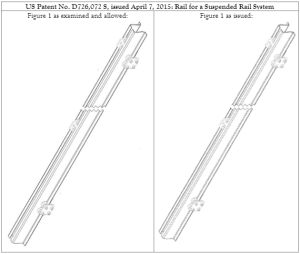
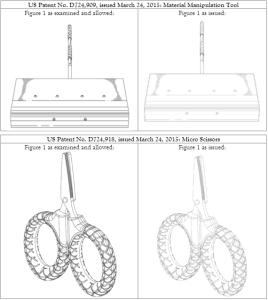
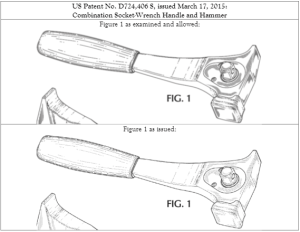
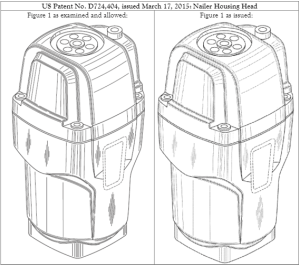
The printing problems in these examples are self-evident. What do the designs really look like? Which parts are claimed, and which are not? How are the designs contoured? These kinds of questions should not be attributable to poor printing quality.
Not all design patents print this poorly. But many do, and that problem merits a solution. Even those patents that print better and more closely represent the designs that were examined and allowed are often still of much lower quality than the drawings provided by the applicant. All would benefit from improved printing.
The Office is capable of issuing patents of such high quality as to rival those issued anywhere else in the world.
When an applicant files a design in color, the Office often prints the resulting patent flawlessly. So, the Office already has a solution to the problem of poor-quality design patents; it simply has not implemented it outside of color designs. The Office should consider printing all design patents through this system, or at least giving applicants the option to have their patents printed through it, even for a fee.
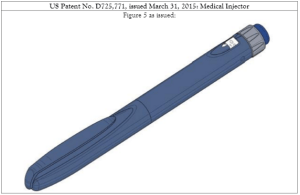
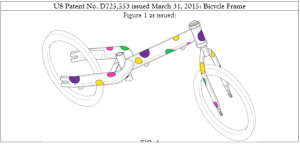
All benefit from improved quality.
The Office clearly wants to improve the quality of issued patents. Improving their print quality is an impactful way to take a big step toward that goal. It will require no additional examiner training or changes to the application process. This clarity will reduce uncertainty in claim scope and will accurately represent the exclusive right that the Office intended to award the patentee. This will benefit both the public and patentees alike.
Respectfully submitted,
Tracy Durkin
Tracy-Gene G. Durkin, Reg. No. 32,831
Director, Mechanical and Design Practice Group Leader, Sterne Kessler
Daniel A. Gajewski
Daniel A. Gajewski, Reg. No. 64,515
Associate, Sterne Kessler
1100 New York Avenue
Washington, D.C. 20005-3934
(202) 371-2600
The views expressed herein are our own and are not to be attributed to any other person or entity including Sterne, Kessler, Goldstein & Fox P.L.L.C., or any client of the firm.
1988054


Re: Comments in response to USPTO’s Request for Comments on Enhancing Patent Quality
May 5, 2015
Commissioner for Patents of the United States Patent and Trademark Office
Attn: Michael Cygan
Senior Legal Advisor, Office of Patent Legal Administration
Office of the Deputy Commissioner for Patent Examination Policy
P.O. Box 1450
Alexandria, VA 22313-1450
via email: WorldClassPatentQuality@uspto.gov
Re: Comments in response to USPTO’s Request for Comments on Enhancing Patent Quality, Fed. Reg. Vol. 80, No. 24 (February 5, 2015)
Dear Commissioner:
We are attorneys with Sterne Kessler Goldstein & Fox, an intellectual property law firm with more than 170 IP professionals in Washington, D.C. In 2014 alone, our firm filed over 1,200 design applications worldwide, over 400 of which were filed at the USPTO. Together, we have over thirty-four years of experience filing and prosecuting design patent applications before the USPTO on behalf of over 100 companies and individuals, including two companies that are regularly among the top fifty annual US design patent grantees.
As a firm and as individual practitioners, we regularly contribute to efforts to shape and improve design prosecution practice. We work with the USPTO and foreign patent offices, and with non-governmental intellectual property groups around the world.
We write today to present the Office with a straightforward, uncontroversial, and necessary suggestion to improve the quality of design patents: print them clearly.
Enhancing the print quality of design patents falls under the Office’s Proposal 3: Clarity of Record.
Clarity in design patent drawings is essential.
The Office’s rules require that a design patent’s claim be in formal terms, covering the design for an article “as shown and described” in the required drawings. 37 CFR §§ 1.152, 1.153. Since the drawings define the claimed subject matter, the Office recognizes the need for high-quality drawings in an application:
The necessity for good drawings in a design patent application cannot be overemphasized. As the drawing constitutes the whole disclosure of the design, it is of utmost importance that it be so well executed both as to clarity of showing and completeness, that nothing regarding the design sought to be patented is left to conjecture.
MPEP § 1503.02. But the MPEP makes no such pronouncement about the quality of drawings in an issued patent.
We contend that high quality drawings are at least as important in an issued patent as in an application. The public deserves to know the extent of the property right protected by a patent, and the patentee deserves to have a clear representation of that right. We do not believe these to be controversial positions.
The print quality of the US Patent Office’s design patents is uniformly low, often obfuscating the exclusive rights they represent.
Design patent drawings often do more than simply depict a design. The types of lines used can be important indicators to represent portions of the design that are claimed, and portions that are not. For example, solid lines are often used to show claimed portions of a design, while broken lines are often used to show unclaimed portions or environment. Shade lines are often used to help show contour. A clear representation of these and other different line types helps the public to understand which portions of a depicted design it may be precluded from practicing.
Unfortunately, the Office’s issued design patents not only consistently fail to represent patented designs with the same clarity with which they were presented in their applications, but even worse, they are often so poor that they are unintelligible or essentially depict a different design than that which was examined and allowed by the examiner.
For example, the printing quality of the Office’s design patents is often so poor that lines in the drawings of the issued patent are not represented as they were in the application. Examples include solid claimed lines appearing as broken unclaimed lines in the issued patent, or boundary and shade lines printing so blurry that they appear to run together, obscuring or misrepresenting portions of the design.
Some examples will help elucidate these points. 1
The printing problems in these examples are self-evident. What do the designs really look like? Which parts are claimed, and which are not? How are the designs contoured? These kinds of questions should not be attributable to poor printing quality.
Not all design patents print this poorly. But many do, and that problem merits a solution. Even those patents that print better and more closely represent the designs that were examined and allowed are often still of much lower quality than the drawings provided by the applicant. All would benefit from improved printing.
The Office is capable of issuing patents of such high quality as to rival those issued anywhere else in the world.
When an applicant files a design in color, the Office often prints the resulting patent flawlessly. So, the Office already has a solution to the problem of poor-quality design patents; it simply has not implemented it outside of color designs. The Office should consider printing all design patents through this system, or at least giving applicants the option to have their patents printed through it, even for a fee.
All benefit from improved quality.
The Office clearly wants to improve the quality of issued patents. Improving their print quality is an impactful way to take a big step toward that goal. It will require no additional examiner training or changes to the application process. This clarity will reduce uncertainty in claim scope and will accurately represent the exclusive right that the Office intended to award the patentee. This will benefit both the public and patentees alike.
Respectfully submitted,
Tracy Durkin
Tracy-Gene G. Durkin, Reg. No. 32,831
Director, Mechanical and Design Practice Group Leader, Sterne Kessler
Daniel A. Gajewski
Daniel A. Gajewski, Reg. No. 64,515
Associate, Sterne Kessler
1100 New York Avenue
Washington, D.C. 20005-3934
(202) 371-2600
The views expressed herein are our own and are not to be attributed to any other person or entity including Sterne, Kessler, Goldstein & Fox P.L.L.C., or any client of the firm.
1988054
Revising Patent Examiner’s Time Allocations
Read MoreA Rallying Cry for Open Data and Open Source Technology in US Elections
Read More